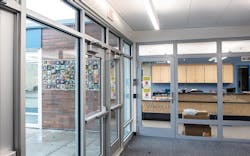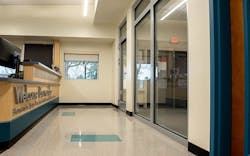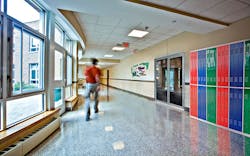Passing Marks: Transferring Safer School Design to Other Applications
Resources like the Partner Alliance for Safer Schools (PASS) K–12 guidelines provide insight into how safer school designs can be a step-by-step process, but these recommendations are still voluntary in many locations. As such, it can be difficult to create consistency between school districts. Additionally, because national building codes do not currently address security, it is possible to use products that are either not effective or violate egress and accessibility requirements.
These concerns make standardizing safer school design practices a crucial step in creating more secure learning environments. If national model codes were to evaluate these best practices and develop a safety and security standard, it would provide guidance as to where, when and how to specify products to raise the baseline of building security. Further, it would ensure security best practices are in conversation with accessibility, fire safety and other building code requirements to reduce potential and unintended conflicts between enhanced security and other forms of protection.
These concerns can inform designers in areas other than the classroom. While the need to safeguard children and faculty has put schools and learning centers in the spotlight when it comes to building codes, the benefits of standardization extend beyond educational environments. Establishing code-driven standards has the potential to help other occupancy types become safer and more secure.
So, what has the building industry learned about enhancing safe school design? And how can design teams apply this knowledge to other building types?
Adapting safer school design to other applications
In a 20-year review from the US Department of Justice, active shooter incidents occurred in 12 location types. While schools (K–12) and institutes of higher education account for a large portion of these incidents, businesses open to pedestrian traffic saw approximately one-third of the active shooter events included in the report.
Further, colleges and universities are classified as a different occupancy type than K–12 schools or businesses open to pedestrian traffic. If building codes included security best practices for these three occupancy types, they could help protect the locations where over two-thirds of active shooter incidents occurred. The question then becomes: in what ways can the PASS K–12 recommendations guide standardizing building security beyond education occupancies?
A multilayer approach to building security is perhaps the most transferable aspect of the PASS K–12 guidelines. Creating layers of protection helps enhance the effectiveness of a complete security plan by providing several points from the property line to the building’s interior to delay violent intruders. It also establishes redundancies should one layer fail. This approach also allows for both access and protection, a key balance for businesses. There are many solutions that can contribute to a layered approach to building security. For example, security-rated glazing can improve a building’s safety without compromising an open and light-filled design.
Incorporating security-rated glazing assemblies at both the building perimeter and interior layers can also help harden entrances and create safe havens within a building without compromising an open and welcoming environment. Going a step further, when these assemblies are made with compatible fire-rated components, they can help satisfy fire- and life-safety code requirements as well.
Products like multifunctional, fire-rated glazing can also work with other security measures common in multiple occupancy types, such as video surveillance systems. This type of glass can safeguard against fire and intruders while preserving open sightlines to adjacent spaces, allowing occupants to potentially see incoming threats and respond accordingly.
Aftermarket products: when secure is not necessarily safe
For both schools and commercial properties, understanding the interplay between security and fire-safety products is crucial in ensuring enhanced security does not inadvertently compromise life safety. Door barricades are a prime example of a product that fulfills one form of safety but may compromise another. While they may be able to control room access, door barricades can violate numerous building codes, including the Americans with Disabilities Act (ADA) requirements for accessibility. Further, they can make it difficult for first responders to quickly access rooms in an emergency. Even though they are not recommended, some school districts still choose to use them, underscoring a need to standardize security practices in educational and commercial building codes.
More recently, there’s been a growing concern around ballistic-rated film. Given glazing’s susceptibility to physical attack, many building professionals have turned to these films to delay violent intruders. While ballistic-rated film can be effective in many areas and is recommended by PASS, it can pose a concern in areas where building materials are required to have a fire rating.
Because these films can burn quickly and intensely, applying them to fire-rated glass could potentially compromise a glazing system’s fire rating. In areas where multiple life safety and security concerns overlap like this, products are now available that have been tested to multiple performance criteria. For example, multifunctional, fire-rated glazing assemblies that are tested as a system or use known compatible components can help enhance the security of a campus without hindering its ability to protect occupants from fire. With code guidance and awareness around security best practices, building professionals can specify products with greater confidence that the entire system will work as intended in the field.
However, while improving building security shares commonalities across all building types, there are key differences to note as well. As such, it is important for security experts and building industry professionals to discuss how best to enhance safety and security across multiple occupancy types, including updating model codes to provide comprehensive and effective security standards. Resources like the PASS K–12 guidelines have been developed by experts well-versed in building codes, ADA requirements and effective security measures, making them a valuable starting point for this discussion.



